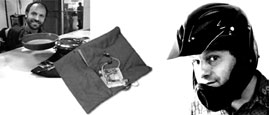Dedication
Introduction
Dan Ariely
Walter Bender
Steve Benton
Bruce Blumberg
V. Michael Bove, Jr.
Cynthia Breazeal
Ike Chuang
Chris Csikszentmihályi
Glorianna Davenport
Judith Donath
Neil Gershenfeld
Hiroshi Ishii
Joe Jacobson
Andy Lippman
Tod Machover
John Maeda
Scott Manalis
Marvin Minsky
William J. Mitchell
Seymour Papert
Joe Paradiso
Sandy Pentland
Rosalind Picard
Mitchel Resnick
Deb Roy
Chris Schmandt
Ted Selker
Barry Vercoe
Ted Selker
I want to make technology that minimizes human and machine energy consumption while maximizing understanding and efficiency.
I want to create toys and tools—and ways of creating toys and tools—that help the world.
I want to take so little that the world will spin forever.
I want to teach people to hold on to good dreams.

Currently, my group works on context-aware computing: creating technologies that demonstrate the context of where things are happening, what is going on, and what has happened before to drive what a machine does. Contextual design can be as simple as the physical ergonomics of children's cups that don't spill, but with mechanical/computer systems it can go much farther. Whenever a "thing" is effectively replaced by a concept, the physical world has been simplified. We have discovered ways of using the way people look at something with their eyes, move their mouse, or walk around things to learn what they want to do, and we have discovered simple ways for machines to learn from a person's reactions to music, interruption, movement and actions to improve computer systems.
The process of creation takes so many forms. The collage of skills, motivations, and collaborations with which we work to solve problems helps shape the kinds of solutions we create. I want to understand and develop empathy for the value of these different contributors to the process of creation.
When we create for expression, the reaction of others is the value. When we create to solve a problem, the function of the creation is the value. When we create scientific understanding, the contribution to the world's knowledge is its value. All creations can be improved by increasing their concern with the reaction of others, their functional value, and their place in the world's knowledge. Just by focusing on problems, inventors with relatively little background have created wonderful things. Imagine what can be done when these creators have computer-supported ways of knowing what they need to know and how to evaluate alternatives as they create.
The analytical fields in science and engineering too seldom inform creation. Our intuition and gut feelings are not adequate tools for understanding technology's impact today. I hope to teach and build tools for all creators to evaluate alternatives and success.
All goals of creation are intellectually tantalizing, but not all are valuable to the world. I try to create and understand technology that minimizes human and machine destructive energy while maximizing understanding.
People can learn the language to use most any tool; but with friends communication seems seamless. We work on recognizing and acting on human intention. We will build enough ways of recognizing what people desire to drive most machine interactions. Knowing when to react is not only noticing that another person wants to help or hurt you, but also knowing when they want to act on these desires. The negotiation of communication is a balance. At the beginning, we ask people to use excessive projections of their intentions to signal systems when it is time to act. As the systems improve, our goal is to take the tool out of the task, making any collaboration of human and machine feel efficient and effortless.
Controlling machines has typically required a human with understanding and memory of how it works. They use explicit directive utterances to get the machines to do anything. Context-aware computing is driven by sensors and artificial intelligence models of the user, the system, and what it can do, as well as the tasks it performs to envision implicit interactions with machines that act as people want them to. Context-aware computing strives to create a world in which people's desires and intentions cause computers to help them.
Favorite childhood toys: a lamp with a plug that I dragged around at age two, LEGO, TV, and radio electronics at 10